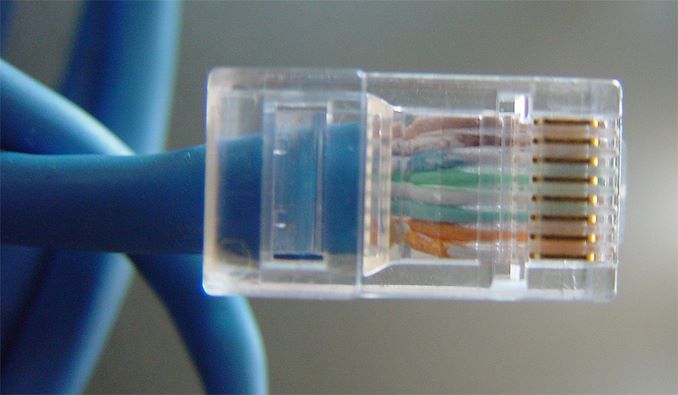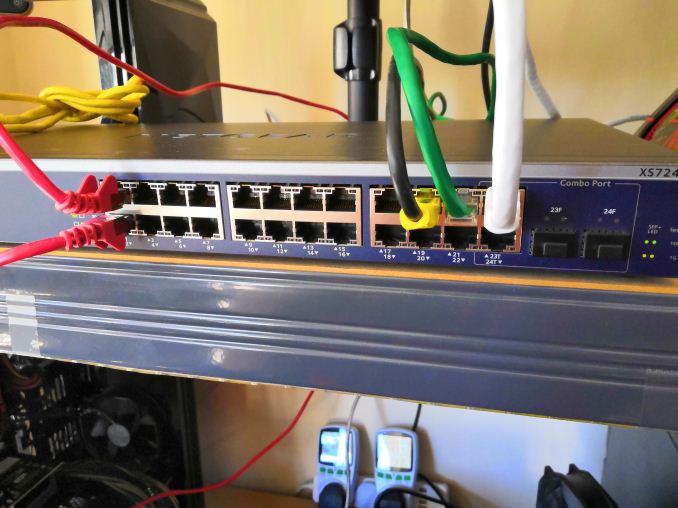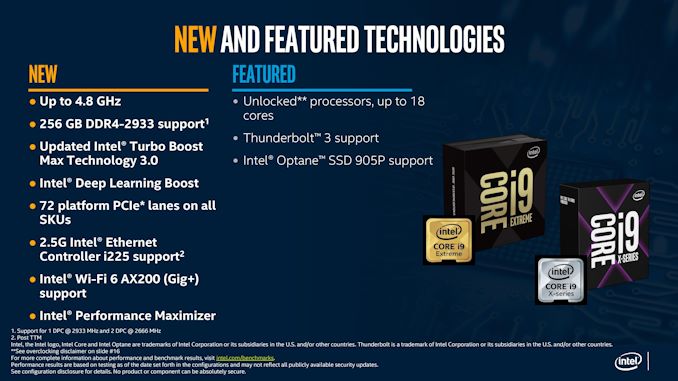Intel Quietly Mentions 2.5 GbE Ethernet Controllers
by Dr. Ian Cutress on October 3, 2019 3:00 PM EST- Posted in
- Networking
- Intel
- Ethernet
- 2.5 GbE
- i225

One of the parts that was quietly mentioned in yesterday’s Cascade Lake X-Series processor launch was support for new Ethernet controllers. Specifically it mentioned Intel’s i225 Ethernet controller range, which are rated for 2.5 GbE networking speed. This is news to us – up until this point, Intel has been relatively quiet on its ‘multi-gigabit’ Ethernet strategy (2.5GbE and 5GbE) and other companies have taken the lead.
Intel’s RJ-45 networking strategy for the last decade has been pretty simple: 1 GbE controllers everywhere, and 10 GbE controllers for enterprise, and some nice margin on the enterprise stuff. The only major update in the 10 GbE strategy in the last few years has been the upgrade from the X540 line to the X550, which moved the PCIe interface from PCIe 2.0 to PCIe 3.0. While other companies have been experimenting with multi-gigabit Ethernet solutions, Intel has been rather quiet.
The market leader in 2.5 GbE and 5 GbE controllers so far has been Aquantia, with their AQC107 and AQC108 chips (plus derivatives). Aquantia was acquired by Marvell earlier this year, and we expect those product lines to be rolled up into Marvell’s naming schemes. Aquantia has had good success with multi-gigabit Ethernet for backhaul connections and automotive, so it will be interesting to see if Marvell will keep the retail channel alive. Aquantia has been the market leader in this space for three years.
The other entrant is Realtek, who released a consumer 2.5 GbE controller earlier this year. This is getting some traction on some consumer motherboards, but is still an outside play – most OEMs are looking at Aquantia’s solution for now. We also have Rivet Networks’ E3000 solution, announced back at CES 2019.
The main barrier to 2.5 GbE and 5.0 GbE adoption has ultimately been the lack of consumer grade multi-port switches. We’ve seen some devices offer single or dual ports up to 2.5 GbE/5 GbE/10 GbE, but these can’t be daisy chained or are limited to the equivalent of peer-to-peer direct connection. Users wanting something bigger, like I did, have to look to the commercial space, such as the XS724EM which more of a multi-user office 24-port switch and costs a pretty penny.
With Intel now set to enter the market with its own 2.5 GbE controller offering, we can hope it means several things. Firstly, that Intel doesn’t see this as a threat to their 10 GbE revenues. Second, hopefully switch manufacturers take the same view, and we see more multi-gigabit Ethernet switches for mainstream customers. Thirdly, we hope that they will be widely available for motherboard manufacturers to use. Given concerns about Intel’s recent 14nm demand issues, it will be interesting to see at what rate these controllers are manufactured.
When speaking with Intel, we were told that availability of the i225 family for its OEM customers will occur later in Q4, as the company ramps up production. So we’re likely to see more of these ports in 2020.
Intel’s ARK database has pages for its i225 controller family. At the time of writing, they incorrectly state that the i225 is a 1 GbE controller – we can confirm they are 2.5 GbE controllers.
Related Reading
- Intel's Cascade Lake-X CPU for High-End Desktops: 18 cores for Under $1000
- Intel Supply in Q4: “Output Capacity up, Supply-Demand Still High”
- Marvell to Acquire Aquantia, Eying Automotive Networking Market
- Qualcomm 5G Home Broadband Reference Design Announced: Aquantia Multi-Gig Ethernet Inside
- Aquantia’s Gamer Edition AQtion AQN-107 10 GbE NIC Available
- Aquantia Multi-Gig: Single Chip USB 3.0 to 5G/2.5G Dongles Coming Soon
- Things We Missed: Realtek Has 2.5G Gaming Ethernet Controllers
- CES 2019: Rivet Networks Killer E3000, a 2.5 GbE Controller












31 Comments
View All Comments
PeachNCream - Thursday, October 3, 2019 - link
"The main barrier to 2.5 GbE and 5.0 GbE adoption has ultimately been the lack of consumer grade multi-port switches."Maybe, but there is also cost, the lack of widespread need, lack of awareness, dominance of wireless networking for endpoints in consumer computing (along with an ever growing absence of wired ethernet hardware in said computers), and the growth of mobile technologies that are displacing existing computing models that have the physical space to support wired network connectivity. I hate to say it, but with Intel being so low-key this might just be an also-ran product intended to check off a feature box so that competitors don't get too far ahead in what is rapidly turning into the networking equivalent of modern retail shopping centers.
James5mith - Thursday, October 3, 2019 - link
Are you talking about laptops exclusively? I can't think of a single desktop system, even a NUC that doesn't come with an ethernet port.PeachNCream - Thursday, October 3, 2019 - link
Yes, I am. The desktop market is rather small these days and looks like the first victim of mobile computing already with noteworthy exceptions in the small form factor and gaming segments (with the gaming desktop segment declining rapidly in quantity as prices rise on premium parts intended to offset volume loss). That market segment is a dead man walking.close - Thursday, October 3, 2019 - link
Most people (consumers) want to have a simple setup. And since they already own probably 5-6+ WiFi devices (phones, tablets, laptops, watches, etc.) they start to care less about wired because WiFi covers all the needs. You get to see wired for the occasional workstation or NAS, for things that simply don't have other options, or just things that sit next to your router anyway. Not too many scenarios actually require the speed (even real 1Gbps, let alone 2.5Gbps).Relatively few people have switches of any kind in the house, short of the one built into the router. So unless manufacturers push 2.5G with regular routers that any regular user would buy, 2.5G switches will pretty much stay a specialty item and expensive for a long while.
Makaveli - Thursday, October 3, 2019 - link
Agreed with your post for most consumers how are novice users.Anyone that cares about performance will not deal with wireless:
Jitter
Interference
less stable connection than wired
I only use Wifi for my cell phones and the laptop from time to time.
Most of my work is done on a Wired desktop pc I have 1Gbps Fiber internet I'm not waiting my time with WiFi.
close - Friday, October 4, 2019 - link
Sure but since we're having the conversation here we can assume we're both "techies". Living in a bubble so to speak. The vast majority of people out there are not. Very few people realistically need to transfer data that fast inside their network and even fewer have a fast enough internet connection to care. So most people don't need to often transfer huge amounts of data fast but they do care about comfort and convenience (no wires) and they *need* WiFi anyway for devices like smartphones.I'm not saying I wouldn't like cheaper, faster networking equipment but from a business perspective it makes sense. You can't make this cheap if only a fraction of a percent care about it in the first place.
Makaveli - Friday, October 4, 2019 - link
Nothing to disagree with there sir you are correct.BurntMyBacon - Monday, October 7, 2019 - link
I agree, but I find it interesting how some of these >1Gbps wireless routers are still connected with 1Gbps hard lines. I suppose that theoretically works for the wireless to wireless transfer scenarios, but I find that use case extremely uncommon in a standard user's setup. The most common transfer is wireless to internet, but there is also the wireless to NAS (or hard lined desktop) scenario. Given that neither of these endpoints can "keep up" with the new wireless standard on a standard 1Gbps connection, it makes little sense for the common user to upgrade their wireless router until at least some of the standard ports are also upgraded. Once the internet interface is upgraded we'll have some headroom to get multigig internet, but that is another story. I suspect multigig will come to consumer grade routers if for no other reason than to facilitate the ever increasing wireless standard speeds. That is unless they start connecting to the internet service provider wirelessly as well. Certainly most consumers don't anything beyond what is currently available (wired or wireless), but most consumers also don't know that they don't need it. What they do know is the advertising saying that their new notebook/phone/tablet supports the newest wireless standard and they are going to need a router that supports the same.peevee - Tuesday, October 8, 2019 - link
I suspect most users do not have a NAS, a few have USB3 hard drives attached to their routers (with speeds limited by hard drive itself), very few have USB3-connected SSDs in which case USB3 speed is plenty to saturate either SSD or WiFi link.But the thing is 2.5G Ethernet should not be any more expensive to mass-produce, so should appear everywhere just because of competitive advantage of higher number on a spec sheet over 1G.
Widespread availability of multi-gig Internet at home at reasonable prices looks to be far away though. And advantages of it are marginal at best. Almost no home user can reasonably justify even 300Mbps over 100Mbps, let alone 2.5Gbps over 1Gbps even if it would be available.
Now, large corporate offices should demand 2.5G on clients with 40G on servers everywhere. After all, employees' time is money.
Jedi2155 - Tuesday, October 8, 2019 - link
I have 23-30 WiFi devices connected to my router, streaming 4K netflix video without issue. Only my personal PC is wired and even then the impact isn't not dramatic when I was using it on wireless.